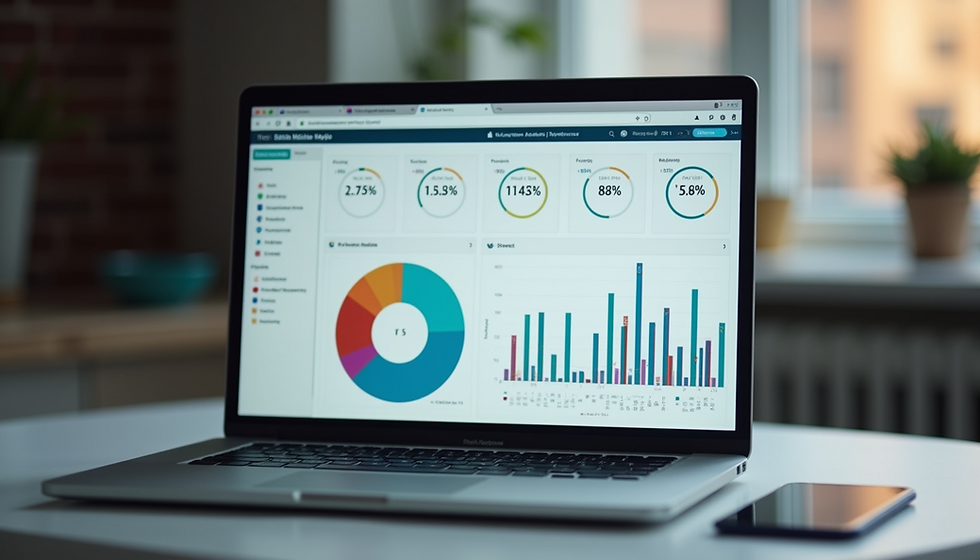The Role of Digital Ads in Modern Marketing
- April Price

- Jun 23
- 4 min read
In today’s fast-paced digital landscape, businesses are constantly searching for effective ways to connect with their audiences. Among the many strategies available, digital advertising stands out as a powerful tool. It allows companies to reach potential customers with targeted messages across various platforms. In this post, we will explore the role of digital ads in modern marketing, their benefits, strategies, and more.
Understanding Digital Ads
Digital ads are promotional messages delivered through online channels like social media, search engines, and websites. Unlike traditional advertising, which may reach a broad audience, digital advertising can target specific demographics based on behavior, interests, and location. For instance, businesses can use Google Ads to display their products to users actively searching for similar items. This targeted approach increases the likelihood of conversions, making digital ads an essential part of any marketing strategy.

According to a report from eMarketer, U.S. digital ad spending topped $200 billion for the first time in 2020 and continues to grow. This indicates a significant shift towards online advertising as companies recognize its potential in engaging consumers effectively.
The Advantages of Digital Ads
One of the most significant advantages of digital ads is the ability to track performance in real time. Marketers can analyze data to understand how their ads are performing, making it easier to adjust strategies as necessary. For example, if a particular ad is underperforming, marketers can easily modify the visuals, copy, or targeting parameters.
Another advantage is the cost-effectiveness of digital ads compared to traditional advertising methods. Platforms like Facebook and Google allow marketers to set their budgets, ensuring that they only spend what they can afford. This flexibility is particularly advantageous for small businesses looking to maximize their return on investment (ROI).

What is the Average Cost of Digital Advertising?
The cost of digital advertising can vary widely depending on the platform, industry, and target audience. For example, the average cost-per-click (CPC) for Google Ads can range from $1 to over $50, depending on the competition for specific keywords.
In terms of social media advertising, platforms like Facebook offer flexible pricing models, where advertisers can spend as little as $2 per day. However, total costs can rise quickly for businesses aiming to reach a larger audience. A study by WordStream found that the average Facebook ad CPC is around $1.72.
Businesses should keep in mind that while cost is essential, it should not be the only factor in determining the effectiveness of an advertising campaign. A higher budget can lead to better visibility and engagement, but it doesn't necessarily translate to sales.
---
Types of Digital Advertising
Digital advertising comes in various formats, each having its unique set of advantages. Here are the most common types:
Search Ads: Appear on search engine results when users type in relevant keywords. They are often labeled as "sponsored."
Display Ads: Visual advertisements appear on websites and apps, typically in the form of banners or sidebar ads.
Social Media Ads: Sponsored posts appear on social media platforms like Facebook, Instagram, and Twitter, often tailored to fit the platform's style.
Video Ads: Short promotional clips that can be displayed before, during, or after streaming video content.
Email Ads: Targeted promotions sent directly to consumers' email inboxes, aimed at encouraging purchases or engagements.
Each of these ad types offers unique benefits, allowing marketers to choose the most effective format for their goals and audience.

Creating Effective Digital Ads
To maximize the effectiveness of digital ads, marketers should follow some best practices:
Know Your Audience: Conduct market research to understand demographics, behaviors, and preferences. Tailored messaging resonates more with the target audience.
Compelling Visuals: Use eye-catching images, graphics, and videos. Visual content typically engages users more compared to text-only ads.
Clear Call to Action (CTA): Ensure that every digital ad has a clear CTA that tells the audience what to do next, whether it’s to buy now, learn more, or sign up.
A/B Testing: Test different versions of ads to see what performs best. Change one element at a time, such as the headline or image, to derive meaningful insights.
Monitor and Adjust: Keep track of performance metrics and adjust advertising strategies as necessary. Analytical tools can help identify areas for improvement.
The Future of Digital Ads
As technology and consumer behaviors evolve, so does the landscape of digital advertising. Here are some trends to watch:
Artificial Intelligence (AI): AI will play an increasingly significant role in personalizing ad experiences and enhancing targeting capabilities.
Voice Search: As voice-activated devices become more common, optimizing for voice search will be crucial for search ads.
Augmented Reality (AR): Brands are starting to incorporate AR into their ads, offering immersive experiences that allow users to interact with products in real-time.
Privacy Considerations: With growing concerns about data privacy, advertisers will need to navigate regulations and changes in data collection practices while still delivering personalized experiences.
By harnessing these trends and focusing on effective digital advertising services, businesses can stay ahead of the competition and more successfully reach their targeted audiences.
Maximizing Your Digital Ad Strategy
In summary, the role of digital ads in modern marketing is crucial. They provide businesses with the tools to target specific audiences, track performance, and adjust campaigns for optimal results. By understanding the various types of digital ads and implementing best practices, marketers can create effective campaigns that drive conversions.
Investing in digital advertising not only increases visibility but also fosters relationships with customers through targeted messaging. Embrace the opportunities that digital advertising presents, and consider leveraging professional digital advertising services to enhance your marketing strategy further.
Digital ads will continue to evolve, but their core purpose remains the same: to connect businesses with consumers in meaningful ways. As marketers adapt to changes in technology and consumer behavior, digital ads will remain an essential pillar of modern marketing strategies.





Comments